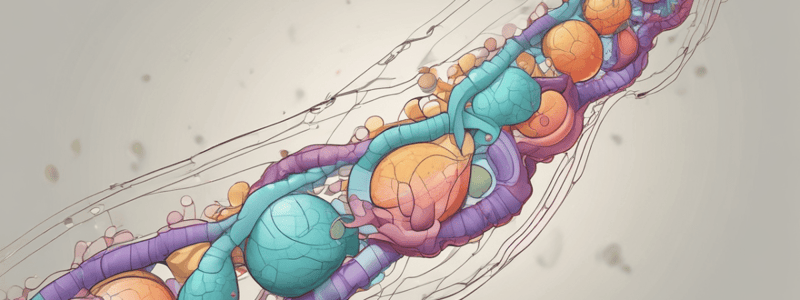Podcast
Questions and Answers
Which macromolecules are involved in the translation process?
Which macromolecules are involved in the translation process?
- Phospholipids and glycolipids
- Polypeptides and RNA molecules of the ribosome (correct)
- Carbohydrates and lipids
- Steroids and nucleotides
At which step do release factors (RFs) play a crucial role in translation?
At which step do release factors (RFs) play a crucial role in translation?
- Activation of tRNA
- Elongation
- Initiation
- Termination (correct)
How many different aminoacyl-tRNA synthetases do most cells contain?
How many different aminoacyl-tRNA synthetases do most cells contain?
- 10
- 30
- 40
- 20 (correct)
What must tRNA molecules possess to ensure proper codon specificity?
What must tRNA molecules possess to ensure proper codon specificity?
Which of the following statements is correct about the translation process?
Which of the following statements is correct about the translation process?
What role does Mg2+ play in translation?
What role does Mg2+ play in translation?
Flashcards are hidden until you start studying
Study Notes
Translation: The Process
- Translation involves various macromolecules, including polypeptides (over 50) and RNA molecules (3-5) that form the ribosome.
- Amino acid activating enzymes (20) and tRNA molecules (32-60) also play a crucial role in the process.
- Soluble proteins facilitate polypeptide chain initiation, elongation, and termination.
- ATP and Mg2+ are essential components of translation.
Distinct Steps in Translation
- The process of translation consists of three stages: initiation, elongation, and termination.
- Termination is triggered by STOP codons UAA, UGA, and UAG, which do not have corresponding tRNAs.
- Release factors (RFs) are involved in the termination stage.
tRNA Characteristics
- tRNA molecules typically consist of 73 to 93 nucleotides.
Stage 1: Activation of the tRNA
- Aminoacyl-tRNA synthetases catalyze the activation of tRNA molecules.
- Each of the 20 aminoacyl-tRNA synthetases links a specific amino acid to its corresponding tRNA.
- In some cells, fewer than 20 synthetases are present, and one amino acid is converted to another after charging the tRNA.
- The correct matching of amino acids with tRNAs can be viewed as the "second genetic code".
- This "code" is based on molecular recognition, where a specific synthetase recognizes a specific tRNA molecule.
Codon Specificity
- Codon specificity resides in the tRNA, not the attached amino acid.
- tRNA molecules must have the correct anticodon sequence.
- tRNA molecules must be recognized by the correct aminoacyl-tRNA synthetase.
- tRNA molecules must bind to the appropriate sites on the ribosomes.
Studying That Suits You
Use AI to generate personalized quizzes and flashcards to suit your learning preferences.




